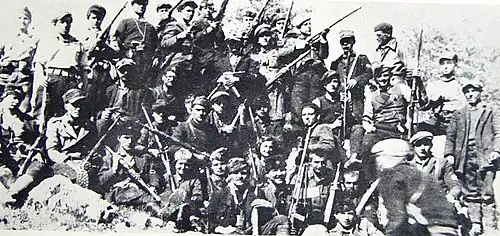Bitola-Prespa Partisan Detachment "Dame Gruev"

"Bitola–Prespa Partisan Detachment “Dame Gruev”(Macedonian: Битолско-преспански партизански одред “Даме Груев“) was a Yugoslav Partisan unit active in Southwestern Macedonia during World War II.[1] Named after revolutionary leader Dame Gruev, it operated within the framework of the National Liberation Army of Macedonia (NOV and POM) and carried out significant military and political actions in the Bitola–Prespa region.[2][3]
History
The detachment was formed on 6 June 1942, on Bigla Mountain above the village of Zlatari, from fighters drawn from the Bitola and Prespa areas.[4] On 2 August 1942, the detachment launched an attack on the municipality building in Smilevo.[5] Shortly after, the unit had some skirmishes with the Bulgarian police.[6]

Hostile pressure from Bulgarian and Italian occupation forces forced the detachment to split into three groups in late 1942: one remained on Bigla Mountain, others dispersed into northern and southern Prespa.[7][8] The southern group, reinforced with new recruits, began acting jointly with Greek partisans in late 1942 and early 1943.[9] In response to intensifying Axis activity, the detachment relocated on 5 April 1943 to the Kostur–Lerin region, where it fought alongside Lerin’s partisan detachment “Vicho” against local collaborators during April–May 1943.[10]
By May 1943, strong reinforcements allowed formation of the new Bitola detachment “Goce Delchev”. The remainder of “Dame Gruev” returned to Prespa and later in July 1943 relocated to Debarca, carrying out sabotage operations and joining the newly-formed “Mirče Acev” battalion.[11] Following Italy’s capitulation on 12 September 1943, partisans from Prespa, together with members of the “Goce Delchev” detachment, disarmed over 200 Italian soldiers near Ljuboјno.[11] In November 1943, these forces were incorporated into the Bitola battalion “Stevan Naumov”. The following year, a detachment of the same name was formed again and operated along the Resen - Bitola road as part of the 49th Division of the Yugoslav People's Army.[12][13][14]
References
- ^ https://prespa.org/borci/VeslievskiNaum/1.pdf
- ^ Даме Груев 1871-1971 (in Macedonian). Друштво за проучување на Илинденските настани "2. август 1903". 1971. page 7
- ^ 1942 (in Macedonian). Radio-telvizija. 1968. page 19
- ^ Makedonija od ustanka do slobode, 1941-1945 (in Macedonian). Vojnoizdavački i novinski centar. 1987.
- ^ Military History of Macedonia (in Macedonian). Military Academy "General Mihailo Apostolski". 2004. ISBN 978-9989-134-05-0. page 573
- ^ "Повик до Македонците да застанат под националното македонско знаме и јуначки да го бранат (1943)" (in Macedonian). 2017-07-05. Retrieved 2025-07-20.
- ^ Избор (in Macedonian). Наша книга. 1975.
- ^ Prilep i Prilepsko vo NOV 1942 godina (in Macedonian). Kultura. 1978.
- ^ Orovo and Its Folks in the Past (in Macedonian). Association of the Refugee Children from the Aegean Part of Macedonia. 2006. ISBN 978-9989-891-14-4. page 59
- ^ Orovo and Its Folks in the Past (in Macedonian). Association of the Refugee Children from the Aegean Part of Macedonia. 2006. ISBN 978-9989-891-14-4.
- ^ a b Ѓорѓи Танковски – Лилин, Јован Д. Кочанковски „Битолско-преспански партизански одред ‘Даме Груев’ (1942-1944)“, Друштво за наука и уметност – Битола, Битола, 1998, 165 стр.
- ^ „Битолските народноослободителни партизански одреди“, Битола, 1982.
- ^ Владо Стрезовски, Ѓорѓи Димовски - Ласков, „7. македонска бригада и 49. дивизија на НОВЈ“, Битола, 1987, стр. 23–31.
- ^ „Македонија од устанка до слободе 1941–1945“. (Зборник радова), Београд, 1987.